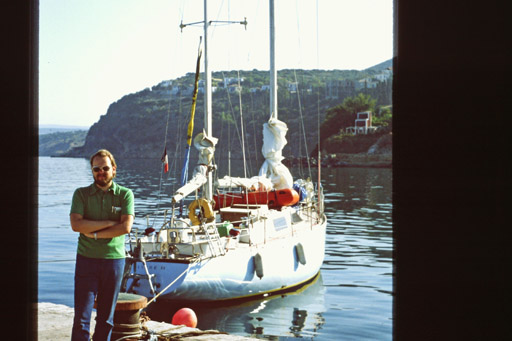Another picture from my 1980 trip. I’ve fled the freezing rain of Northern Europe for the Med, and here we find me on a rare sunny day. Greece turned out to be cold and rainy as hell, and one night I pitched my tent in a tree-sheltered hollow, only to have the rain start to pour down after I went to sleep. When I woke up at maybe 2am, I found my tent was now pitched in a lake, and I had to haul my belongings out of the water toward higher ground, an experience somehow emblematic of the whole trip. My sleeping bag got good and flooded and spent the next day hanging on a clothes line in hopes of drying out.
I happened to be on the quay when this ketch was trying to moor, and I helped haul on lines and otherwise to make myself useful, in vague hope of being able to join the vessel as a deckhand on the next stage of its journey. The skipper was a taciturn Frenchman who was rather impressive in the way of a Nescafe model, but he took no notice of me one way or another.
Maybe he could have used me, because his crew seemed to have deserted. She was a young woman who came ashore in a miniskirt, lots of makeup, and pink plastic boots— au courant for 1980, but she didn’t strike me as a sailor. I last saw her that night partying with a group of Greeks in one of the waterfront taverns. The man, on the other hand, was not to be seen.
I thought about dropping by the tavern and chatting up the lady, but she seemed pretty high-maintenance, so I didn’t.
I made note of the pair and thought I might put them in a story, but I never did.
The town on the cliffs behind me is modern Pylos, as distinct from the ancient Bronze Age palace of Pylos on the northern end of the bay. That Pylos was the home of King Nestor, according the Homer the wisest (and most long-winded) of the Greeks. Nestor’s palace was burned in the aftermath of the general collapse of Bronze Age civilizations that ended the Mycenaeans, as well as the Hittites, Ugarit, Luvians, Babylonians, and various others (the Assyrians and Egyptians barely survived in weakened form). Nestor’s palace is very large and well-preserved, and nearby is a large echoing beehive tomb. The fabulous tomb of the Griffin Warrior wouldn’t be found for another 35 years.
Elsewhere in history, in 425 BCE the Athenians succeeded in trapping a Spartan army on the large island of Sphacteria and forcing their surrender (so much for the myth that Spartans would always fight to the last). The Spartans had to ask for an armistice and came close to conceding the Peloponnesian War.
Much later in 1827, a Franco-British-Russian fleet entered the bay and defeated the Ottoman navy and secured Greek independence. A lot of history for such a small place.
Anyway, I didn’t get to take a boat to Nestor’s palace— probably I went on a bus, but I don’t remember. It was well worth the trip.
The Europeans trips of 1972 and 1975 were paid for by my parents while I was in college, but by this point I was on my own, and the trip was made on the budget of a newly-minted writer of sea-adventure novels. I carried travelers’ checks in one pocket, and dwindling supplies of cash in another. I had a well-hidden credit card for emergencies, and I pitched my tent whenever possible.
The worst part of the trip was not financial anxiety, but the weather, which was relentless. I thought I’d never be warm again.
